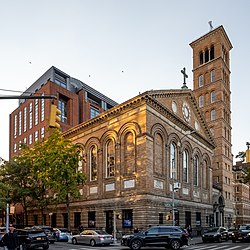
Calvary Baptist Church is an Independent Baptist church, located at 123 West 57th Street between the Avenue of the Americas and Seventh Avenue, near Carnegie Hall in Midtown Manhattan, New York City. As of 2022, the church is at a temporary location while its building at 123 West 57th Street is being demolished and replaced.
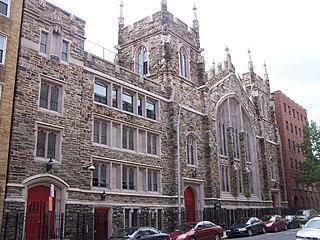
The Abyssinian Baptist Church is a Baptist megachurch located at 132 West 138th Street between Adam Clayton Powell Jr. Boulevard and Lenox Avenue in the Harlem neighborhood of Manhattan, New York City. It is affiliated with the National Baptist Convention, USA and American Baptist Churches USA.
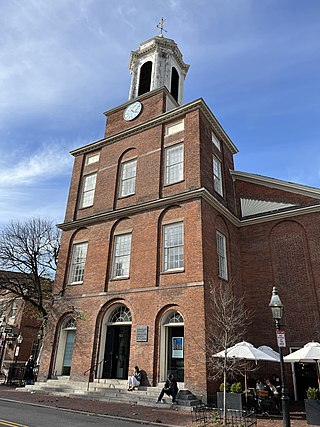
The Charles Street Meeting House is an early-nineteenth-century historic church in Beacon Hill at 70 Charles Street, Boston, Massachusetts.
Reverend Alvin Allison "Al" Carmines Jr. was a key figure in the expansion of off-off-Broadway theatre in the 1960s.

St. John's Baptist Church is a historic church in Miami, Florida. It is located at 1328 Northwest 3rd Avenue. On April 17, 1992, it was added to the U.S. National Register of Historic Places.

The First Baptist Church in the City of New York is a Baptist church based in a sanctuary built in 1890–93 at the intersection of Broadway and West 79th Street in the Upper West Side of Manhattan, New York City. The church is affiliated with the Southern Baptist Convention.

Yorkminster Park Baptist Church is a Baptist church located in Toronto's Deer Park, Canada. It is affiliated with Canadian Baptists of Ontario and Quebec.
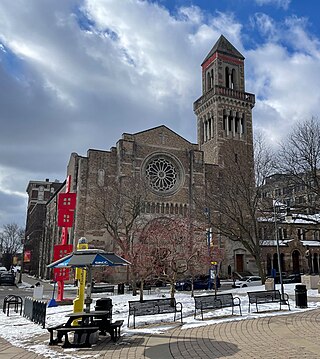
Fountain Street Church (FSC) in Grand Rapids, Michigan, was for a time unique in the United States as being large, religiously liberal and non-denominational in a notably conservative city. The church started out as a Baptist congregation, but it changed its views when liberal Christianity became popular in the late 1800s. Most of the people who influenced this change were graduates of the University of Chicago Divinity School, a pioneer of liberal Christianity.

Fifth Avenue Presbyterian Church is a Presbyterian Church (U.S.A.) church in New York City. The church, on Fifth Avenue at 7 West 55th Street in Midtown Manhattan, has approximately 2,200 members and is one of the larger PCUSA congregations. The church, founded in 1808 as the Cedar Street Presbyterian Church, has been at this site since 1875.

The Central United Methodist Church is located in Downtown Detroit, Michigan. It was designated a Michigan State Historic Site in 1977 and listed on the National Register of Historic Places in 1982.
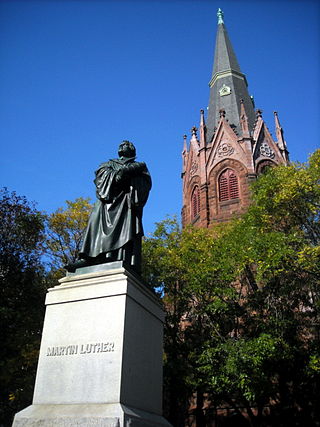
Luther Place Memorial Church is a congregation belonging to the Evangelical Lutheran Church in America. The neo-Gothic church building in Thomas Circle in Washington, D.C., was designed by architects Judson York, J. C. Harkness, and Henry Davis and constructed in 1873 as a memorial to peace and reconciliation following the American Civil War. Its original name was Memorial Evangelical Lutheran Church. The Luther Monument is situated in front of the church. The statue is a replica of the centerpiece of the Luther Monument in Worms, Germany, and was given to the church in 1884 by German emperor William I.

Historic First Bryan Baptist Church is an African-American church that was organized in Savannah, Georgia, by Andrew Bryan in 1788. Considered to be the Mother Church of Black Baptists, the site was purchased in 1793 by Bryan, a former slave who had also purchased his freedom. The first structure was erected there in 1794. By 1800 the congregation was large enough to split: those at Bryan Street took the name of First African Baptist Church, and Second and Third African Baptist churches were also established. The current sanctuary of First Bryan Baptist Church was constructed in 1873.
Judson Health Center, founded in 1921, was an early New York City Community Health Center inspired by the Rev. Alonzo Ray Petty of the Baptist Judson Memorial Church located at 55 Washington Square South.
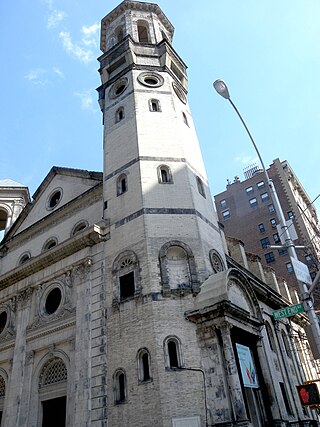
The Church of Saint Paul and Saint Andrew is a historic United Methodist church located in the Upper West Side of New York City, New York, on West 86th Street. The Church is known for being socially liberal and for accepting all people. The Church hosts a number of performing arts groups, including Camerata Notturna, Riverside Orchestra, and New Plaza Cinema.

St. Ann’s Church was the name of a former Roman Catholic parish church at 110-120 East 12th Street between Fourth and Third Avenues in the East Village neighborhood of Manhattan, New York City.
West Presbyterian Church was a congregation and two houses of worship in Manhattan, New York City. The congregation was founded in 1829 and merged in 1911 with Park Presbyterian Church to form West-Park Presbyterian Church. The first house of worship, also known as the Carmine Street Presbyterian Church, in Greenwich Village, was used from 1832 to 1865, and the second, on West 42nd Street between Fifth Avenue and Sixth Avenue, from 1865 until 1911, when it was sold and demolished. Proceeds from the sale were used, in accordance with the merger agreement, to build and endow a church for an underserved neighborhood, Washington Heights: Fort Washington Presbyterian Church. In addition, the West Church congregation had earlier established two mission churches which eventually merged to become Good Shepherd-Faith Presbyterian Church. West-Park, Fort Washington, and Good Shepherd-Faith are all active today.

Second Baptist Church is a Baptist Church located in South Los Angeles, California. The current Lombardy Romanesque Revival building was built in 1926 and has been listed as a Los Angeles Historic-Cultural Monument (1978) and on the National Register of Historic Places (2009). The church has been an important force in the Civil Rights Movement, hosting national conventions of the National Association for the Advancement of Colored Persons ("NAACP") in 1928, 1942, and 1949, and also serving as the site of important speeches by Martin Luther King Jr., Malcolm X, and others. It is affiliated with the American Baptist Churches USA and the Progressive National Baptist Convention.
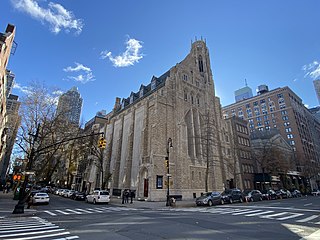
Central Presbyterian Church is a historic congregation on the Upper East Side of Manhattan in New York City, founded by pastor and abolitionist William Patton in 1821. It is a member of the Evangelical Presbyterian Church, and it worships in a Gothic Revival structure completed in 1922 that was originally commissioned and largely funded by John D. Rockefeller Jr. as Park Avenue Baptist Church.

The First Baptist Church of Greater Cleveland is an historic Baptist church in Shaker Heights, Ohio. Founded in 1833, it was the first Baptist church in the Cleveland, Ohio area and is the fourth oldest church in Cleveland.
Howard Russell Moody was an American clergyman who served as a pastor at Judson Memorial Church in New York City for 35 years. He was also a longtime champion of civil rights and free expression.
